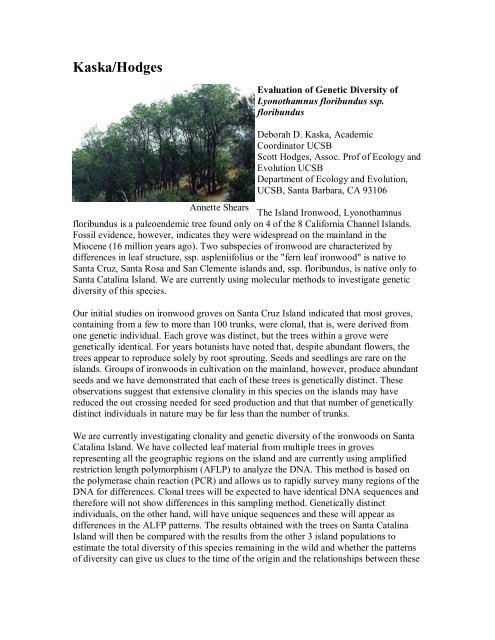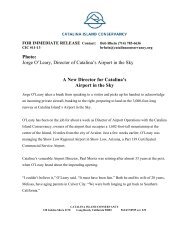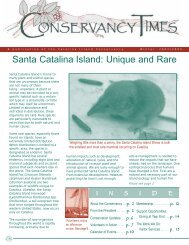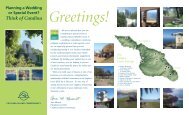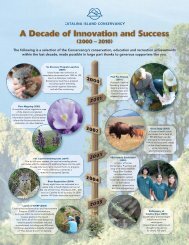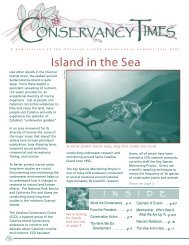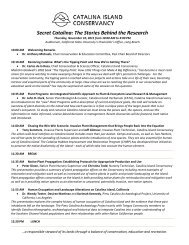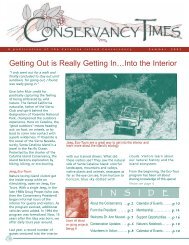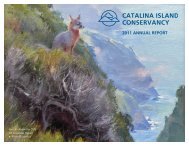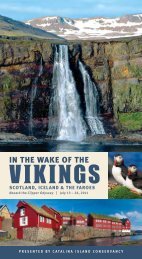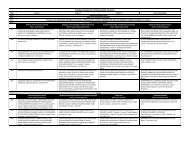Kaska, Deborah D. - Catalina Island Conservancy
Kaska, Deborah D. - Catalina Island Conservancy
Kaska, Deborah D. - Catalina Island Conservancy
Create successful ePaper yourself
Turn your PDF publications into a flip-book with our unique Google optimized e-Paper software.
<strong>Kaska</strong>/HodgesEvaluation of Genetic Diversity ofLyonothamnus floribundus ssp.floribundus<strong>Deborah</strong> D. <strong>Kaska</strong>, AcademicCoordinator UCSBScott Hodges, Assoc. Prof of Ecology andEvolution UCSBDepartment of Ecology and Evolution,UCSB, Santa Barbara, CA 93106Annette ShearsThe <strong>Island</strong> Ironwood, Lyonothamnusfloribundus is a paleoendemic tree found only on 4 of the 8 California Channel <strong>Island</strong>s.Fossil evidence, however, indicates they were widespread on the mainland in theMiocene (16 million years ago). Two subspecies of ironwood are characterized bydifferences in leaf structure, ssp. aspleniifolius or the "fern leaf ironwood" is native toSanta Cruz, Santa Rosa and San Clemente islands and, ssp. floribundus, is native only toSanta <strong>Catalina</strong> <strong>Island</strong>. We are currently using molecular methods to investigate geneticdiversity of this species.Our initial studies on ironwood groves on Santa Cruz <strong>Island</strong> indicated that most groves,containing from a few to more than 100 trunks, were clonal, that is, were derived fromone genetic individual. Each grove was distinct, but the trees within a grove weregenetically identical. For years botanists have noted that, despite abundant flowers, thetrees appear to reproduce solely by root sprouting. Seeds and seedlings are rare on theislands. Groups of ironwoods in cultivation on the mainland, however, produce abundantseeds and we have demonstrated that each of these trees is genetically distinct. Theseobservations suggest that extensive clonality in this species on the islands may havereduced the out crossing needed for seed production and that that number of geneticallydistinct individuals in nature may be far less than the number of trunks.We are currently investigating clonality and genetic diversity of the ironwoods on Santa<strong>Catalina</strong> <strong>Island</strong>. We have collected leaf material from multiple trees in grovesrepresenting all the geographic regions on the island and are currently using amplifiedrestriction length polymorphism (AFLP) to analyze the DNA. This method is based onthe polymerase chain reaction (PCR) and allows us to rapidly survey many regions of theDNA for differences. Clonal trees will be expected to have identical DNA sequences andtherefore will not show differences in this sampling method. Genetically distinctindividuals, on the other hand, will have unique sequences and these will appear asdifferences in the ALFP patterns. The results obtained with the trees on Santa <strong>Catalina</strong><strong>Island</strong> will then be compared with the results from the other 3 island populations toestimate the total diversity of this species remaining in the wild and whether the patternsof diversity can give us clues to the time of the origin and the relationships between these
island populations.


